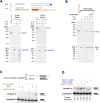Ustilago maydis telomere protein Pot1 harbors an extra N-terminal OB fold and regulates homology-directed DNA repair factors in a dichotomous and context-dependent manner
- PMID: 35587917
- PMCID: PMC9119445
- DOI: 10.1371/journal.pgen.1010182
Ustilago maydis telomere protein Pot1 harbors an extra N-terminal OB fold and regulates homology-directed DNA repair factors in a dichotomous and context-dependent manner
Abstract
The telomere G-strand binding protein Pot1 plays multifaceted roles in telomere maintenance and protection. We examined the structure and activities of Pot1 in Ustilago maydis, a fungal model that recapitulates key features of mammalian telomere regulation. Compared to the well-characterized primate and fission yeast Pot1 orthologs, UmPot1 harbors an extra N-terminal OB-fold domain (OB-N), which was recently shown to be present in most metazoans. UmPot1 binds directly to Rad51 and regulates the latter's strand exchange activity. Deleting the OB-N domain, which is implicated in Rad51-binding, caused telomere shortening, suggesting that Pot1-Rad51 interaction facilitates telomere maintenance. Depleting Pot1 through transcriptional repression triggered growth arrest as well as rampant recombination, leading to multiple telomere aberrations. In addition, telomere repeat RNAs transcribed from both the G- and C-strand were dramatically up-regulated, and this was accompanied by elevated levels of telomere RNA-DNA hybrids. Telomere abnormalities of pot1-deficient cells were suppressed, and cell viability was restored by the deletion of genes encoding Rad51 or Brh2 (the BRCA2 ortholog), indicating that homology-directed repair (HDR) proteins are key mediators of telomere aberrations and cellular toxicity. Together, these observations underscore the complex physical and functional interactions between Pot1 and DNA repair factors, leading to context-dependent and dichotomous effects of HDR proteins on telomere maintenance and protection.
Conflict of interest statement
The authors have declared that no competing interests exist.
Figures






Similar articles
-
Ustilago maydis Trf2 ensures genome stability by antagonizing Blm-mediated telomere recombination: Fine-tuning DNA repair factor activity at telomeres through opposing regulations.PLoS Genet. 2024 Dec 9;20(12):e1011515. doi: 10.1371/journal.pgen.1011515. eCollection 2024 Dec. PLoS Genet. 2024. PMID: 39652599 Free PMC article.
-
Brh2 and Rad51 promote telomere maintenance in Ustilago maydis, a new model system of DNA repair proteins at telomeres.DNA Repair (Amst). 2013 Jul;12(7):472-9. doi: 10.1016/j.dnarep.2013.04.027. Epub 2013 May 28. DNA Repair (Amst). 2013. PMID: 23726221 Free PMC article.
-
TPP1 is a homologue of ciliate TEBP-beta and interacts with POT1 to recruit telomerase.Nature. 2007 Feb 1;445(7127):559-62. doi: 10.1038/nature05469. Epub 2007 Jan 21. Nature. 2007. PMID: 17237767
-
Exploring Genetic Interactions with Telomere Protection Gene pot1 in Fission Yeast.Biomolecules. 2023 Feb 15;13(2):370. doi: 10.3390/biom13020370. Biomolecules. 2023. PMID: 36830739 Free PMC article. Review.
-
Predicted elements of telomere organization and function in Ustilago maydis.Fungal Genet Biol. 2008 Aug;45 Suppl 1:S54-62. doi: 10.1016/j.fgb.2008.04.009. Epub 2008 May 29. Fungal Genet Biol. 2008. PMID: 18514000 Review.
Cited by
-
Ustilago maydis Trf2 ensures genome stability by antagonizing Blm-mediated telomere recombination: Fine-tuning DNA repair factor activity at telomeres through opposing regulations.PLoS Genet. 2024 Dec 9;20(12):e1011515. doi: 10.1371/journal.pgen.1011515. eCollection 2024 Dec. PLoS Genet. 2024. PMID: 39652599 Free PMC article.
-
Molecular architecture and oligomerization of Candida glabrata Cdc13 underpin its telomeric DNA-binding and unfolding activity.Nucleic Acids Res. 2023 Jan 25;51(2):668-686. doi: 10.1093/nar/gkac1261. Nucleic Acids Res. 2023. PMID: 36629261 Free PMC article.
-
Comparative genomics of Cryptococcus and Kwoniella reveals pathogenesis evolution and contrasting karyotype dynamics via intercentromeric recombination or chromosome fusion.bioRxiv [Preprint]. 2024 Jan 13:2023.12.27.573464. doi: 10.1101/2023.12.27.573464. bioRxiv. 2024. Update in: PLoS Biol. 2024 Jun 6;22(6):e3002682. doi: 10.1371/journal.pbio.3002682. PMID: 38234769 Free PMC article. Updated. Preprint.
-
The yeast CST and Polα/primase complexes act in concert to ensure proper telomere maintenance and protection.Nucleic Acids Res. 2025 Apr 10;53(7):gkaf245. doi: 10.1093/nar/gkaf245. Nucleic Acids Res. 2025. PMID: 40245101 Free PMC article.
-
Comparative genomics of the closely related fungal genera Cryptococcus and Kwoniella reveals karyotype dynamics and suggests evolutionary mechanisms of pathogenesis.PLoS Biol. 2024 Jun 6;22(6):e3002682. doi: 10.1371/journal.pbio.3002682. eCollection 2024 Jun. PLoS Biol. 2024. PMID: 38843310 Free PMC article.
References
Publication types
MeSH terms
Substances
Supplementary concepts
Grants and funding
LinkOut - more resources
Full Text Sources
Research Materials
Miscellaneous

